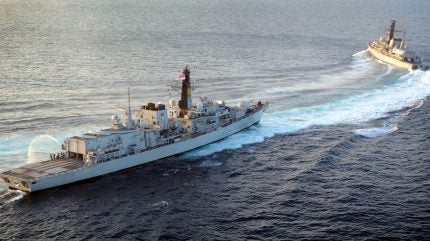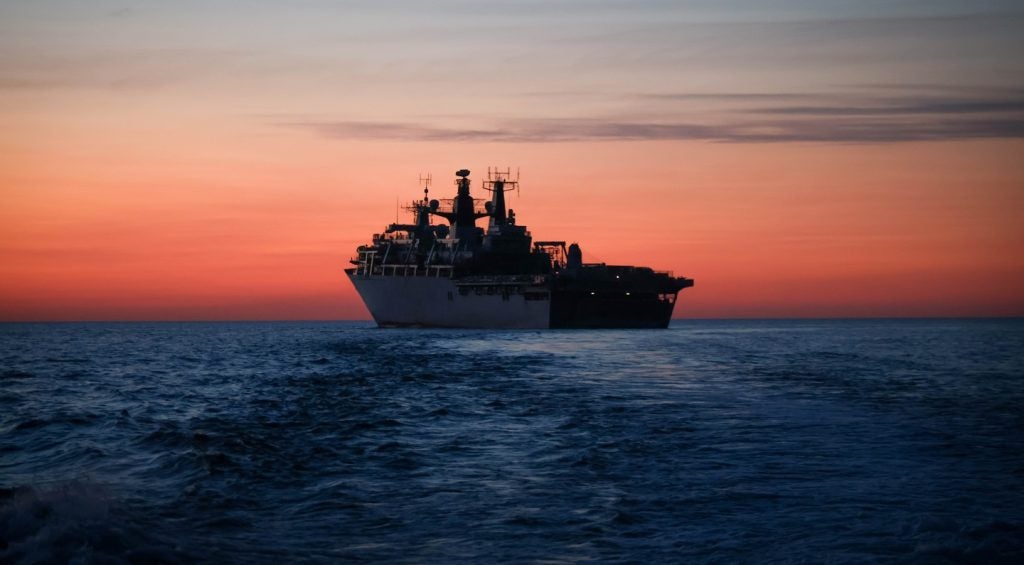
In a Jekyll and Hyde announcement of unprecedented proportions in contemporary UK politics, the UK simultaneously announced a new “Golden Age of shipbuilding” at the same time as cutting the Royal Navy’s fighting capability with the departure of two Type 23 frigates, further reducing a once-numerous force to single figures.
Detailed on 14 May 2024, at the foot of a UK Government release, the revelation that the UK Royal Navy’s surface combatant force for the foreseeable future will comprise just 15 Type 23 frigates and Type 45 destroyers was made at the same time that UK Defence Secretary Grant Shapps declared a “Golden Age of Shipbuilding” for the UK, with the commitment to build six new Multi-Role Support Ships (MRSS).
In a keynote speech at First Sea Lord’s Sea Power Conference in London, Shapps said that the “Golden Age” would see 28 surface vessels and submarines delivered in the years ahead, which was backed by a UK Government commitment to increase defence spending to 2.5% of GDP by 2030.
However, Type 23 frigates HMS Westminster and HMS Argyll will be axed from service, with the vessels being respectively retired and sold back to former manufacturer, BAE Systems.
Analysis: Royal Navy frigates cut to the bone
This means the UK Royal Navy’s frigate force will have just nine Type 23 frigates in service as the ageing warships increasingly require extensive re-certification and maintenance programmes to keep them operational.
This new drop in hull numbers is sinks a worst-case scenario report by Naval Technology earlier this year, which forecast a reduction to nine Type 23 frigates by 2027.
It was known that HMS Westminster was in poor condition as it languished alongside, a ship-of-the-line in name only. However, the loss of HMS Argyll, which was thought likely to continue in service until the 2027/28 timeframe after undergoing a modernisation programme in 2022, is a significant loss.
The axeing of the two further Type 23 frigates follows the retirement of HMS Monmouth and HMS Montrose in 2021 and 2023, vessels which were intended to remain in service until 2026 and 2027 respectively.
Given the delivery path for the Type 31 and Type 26 frigates lean towards 2028 and 2030 at the earliest, it will be several years before the Royal Navy can even consider to regenerate hull numbers towards the mandated 19 frigates and destroyers required to carry out all its operational taskings.
Taking to social media later in the day, Shapps further announced that “all Royal Navy frigates” would have a land attack capability, a fact already well understood with the 2023 commitment to fit the Mk 41 vertical launch system to the Type 31 frigates, which will likely occur during capability insertion period, also known as ‘fitted-for-but-not-with’.
The land attack capability will almost certainly be provided by the Tomahawk cruise missile, potentially the Maritime Strike Tomahawk variant that offers both sea and land attack functions. Delivery timelines are unknown, with the US being the main lead in the programme, leaving the UK dependent on Washington’s priorities.
Availability for the Type 45 air defence destroyers is also a problem as each of the six undergo the Power Improvement Programme intended to rectify propulsion and electrical issues that have plagued the class since entering service more than a decade ago.
The solution, which requires cutting huge holes in the hulls in order to install new diesel generators, effectively changes the propulsion configuration of the Type 45s from an all-electric drive gas turbine setup to a more conventional Combined Diesel and Gas (CODAG) arrangement.
What does a UK shipbuilding “Golden Age” look like?
The heralded “Golden Age” in UK shipbuilding, a phrase which could well come back to haunt its speaker, consists of eight Type 26 and five Type 31 frigates under construction, as well as the final hulls of the six Astute-class nuclear powered attacks submarines, in addition to the four Dreadnought-class nuclear powered ballistic missile submarines, and three Future Solid Support Ships.
Also announced on 14 May were the MRSS vessels intended to replace a range of vessels in service with the Royal Navy and Royal Fleet Auxiliary (RFA).
The UK said that be “up to six” MRSS built overall, which will replace current capabilities, including the two Landing Platform Docks, three Landing Ship Dock (Auxiliaries) and the Aviation Support Ship RFA Argus, in the early 2030s.
Breaking down the numbers, the reference to “up to six” indicates the potential for a real-terms cut in Royal Navy and RFA logistics and amphibious force hull numbers as the three hulls of the Bay-class, the landing platform docks HMS Albion and HMS Bulwark, and Aviation Support Ship RFA Argus leave service next decade.
The fig leaf commitment to retain HMS Albion and HMS Bulwark, the Royal Navy’s current amphibious flagships, until 2033/2034 sustains their presence in the short term, although since 2010 only a single vessel has been active with the others placed in long-term regeneration in Devonport that typically last for a number of years.
With HMS Bulwark having just entered long-term regeneration, the next years of HMS Albion’s in Royal Navy service could be its last.

The Royal Navy stated that the UK Ministry of Defence has entered the concept phase of the MRSS programme and will “work with industry as part of early market engagement” ahead of developing the vessel design.
In effect, the “Golden Age” will see an at best like-for-like replacement of six Royal Navy and RFA hulls with “up to six” MRSS vessels, and at worst a further reduction in hull numbers.
The UK Royal Navy – a spent force or a future naval Phoenix?
Royal Navy surface combatant numbers, on current plans, will reach 19 from the mid-2030s if the builds of the Type 31 and Type 26 are not delayed. China, by contrast, counts 153 major surface combatants in its navy, according to recently revealed data by the US Office for Naval Intelligence.
Far from a Golden Age, the announcement takes the expected decision to further axe Type 23 frigates with the Royal Navy not expected to be back into double figures for its surface workhorse fleet until 2030 at the earliest as the Type 31s come online.
The picture theoretically begins to improve in the late-2020s, with either two or three Type 31 frigates handed over to the Royal Navy in 2027 and 2028, with a single Type 26 commissioned into service from 2028 through to 2035 when the final vessel (HMS London) arrives.
Nevertheless, the Royal Navy is entering a period of unprecedented difficulty, capability gapping and cutting hull numbers for the promise of a new dawn at some point from 2030 onwards.




